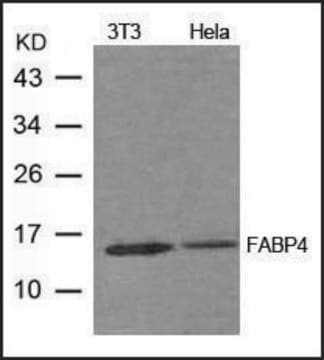AB5731
Anti-Nanog Antibody, NT
Chemicon®, from rabbit
Synonym(e):
Homeobox transcription factor Nanog, Nanog homeobox
About This Item
Empfohlene Produkte
Biologische Quelle
rabbit
Qualitätsniveau
Antikörperform
affinity purified immunoglobulin
Antikörper-Produkttyp
primary antibodies
Klon
polyclonal
Aufgereinigt durch
affinity chromatography
Speziesreaktivität
human, rat, mouse
Verpackung
antibody small pack of 25 μg
Hersteller/Markenname
Chemicon®
Methode(n)
western blot: suitable
Aufnahme
sample type: mouse embryonic stem cell(s)
sample type induced pluripotent stem cell(s)
sample type: human embryonic stem cell(s)
Isotyp
IgG
NCBI-Hinterlegungsnummer
UniProt-Hinterlegungsnummer
Versandbedingung
ambient
Lagertemp.
2-8°C
Posttranslationale Modifikation Target
unmodified
Angaben zum Gen
human ... NANOG(79923)
mouse ... Nanog(71950)
Allgemeine Beschreibung
NANOG may be useful in the immunohistochemical diagnosis of tumors. NANOG is expressed in germ cells of the fetus and in some germ cell tumors of the gonads and central nervous system (CNS).
Spezifität
Immunogen
Anwendung
Stammzellforschung
Pluripotente Stammzellen & Stammzellen der frühen Entwicklungsphase
0.5-1.0 µg/mL. The antibody recognizes a protein of ~35 kDa on NT2/D1 cell lysate. Additional bands of ~55 and ~130 kDa may be seen depending on sample and antibody dilution used.Optimal working dilutions must be determined by the end user.
Qualität
Western Blot Analysis:
1:500 dilution of this lot detected NANOG on 10 μg of Embryonic Mouse Brain lysates
Zielbeschreibung
Physikalische Form
Lagerung und Haltbarkeit
Hinweis zur Analyse
Whole cell lysate from mouse embryonic stem cells.
Sonstige Hinweise
Rechtliche Hinweise
Haftungsausschluss
Not finding the right product?
Try our Produkt-Auswahlhilfe.
Empfehlung
Analysenzertifikate (COA)
Suchen Sie nach Analysenzertifikate (COA), indem Sie die Lot-/Chargennummer des Produkts eingeben. Lot- und Chargennummern sind auf dem Produktetikett hinter den Wörtern ‘Lot’ oder ‘Batch’ (Lot oder Charge) zu finden.
Besitzen Sie dieses Produkt bereits?
In der Dokumentenbibliothek finden Sie die Dokumentation zu den Produkten, die Sie kürzlich erworben haben.
Unser Team von Wissenschaftlern verfügt über Erfahrung in allen Forschungsbereichen einschließlich Life Science, Materialwissenschaften, chemischer Synthese, Chromatographie, Analytik und vielen mehr..
Setzen Sie sich mit dem technischen Dienst in Verbindung.








